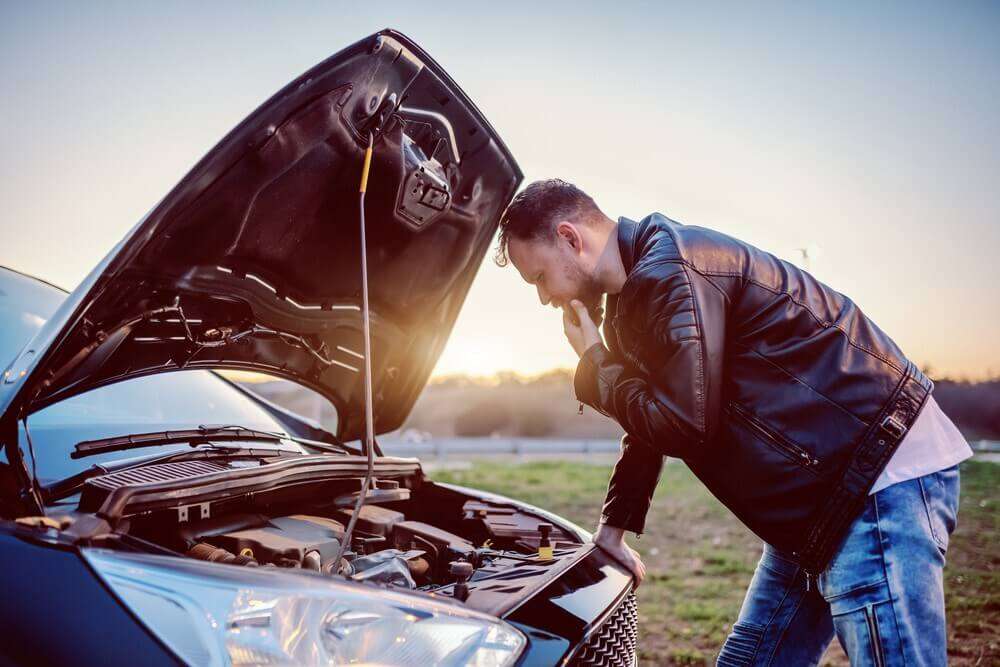The most common reason for a car not to start is a faulty starter motor. If you have ever found yourself in the unfortunate position of being stranded on the side of the road with a car that won’t start, don’t panic! This article will tell you everything you need to know about what to do to fix it.
We will go over how starters work and discuss some things that can cause them problems, like corrosion and overheating. We will also offer some troubleshooting tips if your vehicle has experienced any issues with starting recently.
Finally, we will give specific advice on what steps should be taken if your starter motor needs replacing to save both time and money.
Jump to
- 1 What is a Starter Motor?
- 2 Symptoms of Bad Starter
- 3 How To Start a Car with a Bad Starter?
- 3.1 Method 1: Slowly Hitting Starter Motor with Hammer
- 3.2 Methods 2: Use Your Car Battery Charger
- 3.3 Method 3: Kick-Start the Car
- 3.4 Method 4: Check Loose Connections
- 3.5 Method 5: Tightening Engine Ground Connection
- 3.6 Method 6: Check Solenoid Cable
- 3.7 Method 7: Use Jumper Leads to Start the Car
- 3.8 Method 8: Check for Rust and Dust on the Starter Motor
- 3.9 Method 9: Clean Corroded Battery Terminals or Starter Motor
- 3.10 Method 10: Ask Someone to Push the Car – For Vehicles with Manual Gear
- 4 FAQs
What is a Starter Motor?
Starter motors are responsible for turning over, or ‘cranking’, an engine when the ignition key is turned in the start position. They usually consist of an electric motor driving cable that engages teeth on the flywheel of the engine to spin it into life and eventually start it.
The starter is usually housed inside the engine bay and connected to the rest of the car via a thick cable that runs through either an ‘access hole’ in the bulkhead or under the vehicle.
Symptoms of Bad Starter
The starter is a vital part of every car, and when they break, the result is usually catastrophic. Without a motor to spin the engine into life, the car will be left stranded and out of action.
The most common symptoms of a starter motor going bad are:
- The car won’t start.
- A clicking noise can be heard coming from the engine bay when trying to start the car.
- If you listen closely, other noises such as squealing or grinding can also be heard coming from the engine bay.
- Starting Speed is slower than normal.
- The starter motor can fail intermittently, meaning it may work sometimes and not work at others. If this is the case, you might be able to start the car sometimes, but not others.
How To Start a Car with a Bad Starter?
Fixing a bad starter motor can be very expensive, so it is vital to try and fix the issue yourself before taking your vehicle into a garage.
Here are ten methods you can try if your car is suffering from a bad starter motor.
Method 1: Slowly Hitting Starter Motor with Hammer
Yes, you heard it right; the good old-fashioned hammer method still works and will have your car roaring into life in no time if you find yourself stuck on the side of the road.
The best way to do this is to place the end of the hammer on the starter motor and then gently tap it with a small hammer to get it turning. It is better if you hit the starter motor and also crank the car at the same time. This method is absolutely effective and has worked for many people.
Methods 2: Use Your Car Battery Charger
If your battery is low and If you have access to a car battery charger, you can try using this method to start your car. Connect your charger to the battery and turn it on. If the car doesn’t start, keep trying the engine each time you charge the battery for a few minutes until it does.
This method works best if you are sure that your starter motor has gone faulty and there is nothing else wrong with your engine or ignition.
Method 3: Kick-Start the Car
If your car is suffering from a bad starter motor, you can try to manually kick-start the engine. It sounds like an extreme measure, but it will at least get the car off of the road and into a safe place whilst you sort out what to do next.
Successful use of this method depends on how good you are at kicking a car, as well as the condition of the car’s engine. This method is time-consuming and frustrating but could save you money in the long run if an unreliable starter motor is to blame for your vehicle not starting.
Method 4: Check Loose Connections
There is a possibility that your car isn’t suffering from a bad starter motor, but rather that the faulty part has caused one of the connections to become loose. Before you get your vehicle repaired, it’s worth taking 10 minutes to check all of the battery terminals and connection points on your car engine.

Method 5: Tightening Engine Ground Connection
A loose ground connection can be found by examining the three main engine ground points.
If you suspect a bad starter motor, check each of these connections to ensure that they have a tight fit and are clean of corrosion. If you find a loose ground connection, you can use an appropriate connector to repair it.
Method 6: Check Solenoid Cable
If you are confident that your starter motor has gone bad, it is worth checking the solenoid cable before you get a new one.
You can find the starter solenoid cable by moving to the front of the vehicle and looking underneath where the starter can be located. The solenoid cable should run from the engine bay to where it connects with the starter.
You can check the solenoid cable for damage by using a multimeter to see if there is power running through it. You can do this by touching the two ends of the cable with the multimeter probes. If your starter motor is suffering from a bad solenoid, this test will show a zero reading.
Method 7: Use Jumper Leads to Start the Car
Using jumper leads is a tried and tested method of getting a car to start; it is commonly used in instances where the battery has died. Connecting both your car’s battery terminals to another battery can give enough power for the engine to turn over.
Connect one end of the jumper leading to your car battery and the other between another vehicle’s positive terminal and its battery. Once you connect the lead, you should see your car’s engine turning over as soon as it receives a new power source.
You will get the best results from this method if you use a vehicle that is running to help start your dead one because it can provide more power than an old battery alone.
Method 8: Check for Rust and Dust on the Starter Motor
If you find that your car turns on its starter motor but then stops, it might be a good idea to check if there is any rust or dust on the starter motor. If there is some rust present, it might be a good idea to clean it off and then see if that helps.
You should be able to get rid of it by using a screwdriver and then scraping the dust off. This will keep your engine from clogging up with a lot of dirt, which can cause it to malfunction
Method 9: Clean Corroded Battery Terminals or Starter Motor
For Battery: It is common to find that the battery terminals are corroded, and you might need to check them if your car has trouble starting up.
You can try cleaning them with distilled water or baking soda and then see if that helps.
For Starter Motor: Corrosion on the starter motor can cause it to become a lot less efficient. Corrosion can prevent the proper flow of current, and in the end, your engine will not be able to start. A way to get rid of corrosion buildup is by rubbing it off with a mixture of water and sodium bicarbonate. This will eliminate the corroded surface layer and will clean your starter motor as well.
Method 10: Ask Someone to Push the Car – For Vehicles with Manual Gear
One of the simplest ways to get it started is to ask someone else who has a working vehicle to push your car and make sure your ignition key is turned to the “start” position and your car is in first or second gear. When your car reaches some decent speed (10-20 MPH), you should release the clutch pedal, and your engine should start.
FAQs
-
Why does hitting a starter make it work?
The brushes on the starter have to be hitting their contact just right for the engine to start. When you hit it, it slightly moves the brushes in a different position, which may allow the starter to work for some time.
-
Does Hitting a Starter Damage the Starter
Hitting a starter usually only gives you one try at starting the car; repeated attempts may damage your starter over time. Instead, look into your car manual to see what the manufacturer recommends for starting a car with a bad starter.
-
What can kill a car starter?
Overheating can damage a car starter. If the engine temperature is too high, the starter can overheat, which could make it difficult to start your car. However, note that overheating is not the only cause of starter problems.
-
How much does it cost to fix the starter on a car?
Estimates vary depending on the issue. For example, a local mechanic may charge around $175 to replace the starter. A dealership or specialized shop may cost a bit more depending on the labor costs.
-
What to do if the starter doesn’t work?
You can try some of the methods mentioned above to start the car. However, if the starter continues to have issues, you may want to consult with a mechanic for repairs.
Final Thoughts!
Whether you have a bad starter or your car battery is dead, and the vehicle won’t start, there are many ways to get it going. We’ve compiled ten different methods for how to start a car with a bad starter that can help in any situation.
If all else fails and none of these solutions help get your engine started, it’s important not to panic! The best thing to do in a situation like this is to call roadside assistance or have someone tow you home so that professionals can diagnose the problem properly.
Also Read: What are the Symptoms of a Bad Oxygen Sensor?

My name is Tom Harris, founder of this blog. I’m a mechanical engineer with 20 years of experience in the automotive industry. I’m here to help you with your vehicle’s problems, easy fixes and share my insights and experience so that you can enjoy your rides more.

